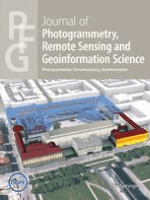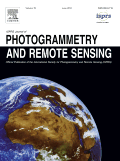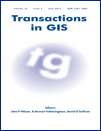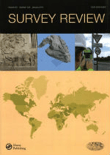
Boletim de Ciencias Geodesicas
Scope & Guideline
Innovating the Future of Earth and Planetary Sciences
Introduction
Aims and Scopes
- Geospatial Data Analysis and Modeling:
The journal focuses on the analysis and modeling of geospatial data, including the use of advanced statistical and computational methods to interpret complex spatial patterns and dynamics. - Remote Sensing and Image Processing:
A significant emphasis is placed on remote sensing technologies and image processing techniques, exploring their application in environmental monitoring, urban planning, and resource management. - Geodetic Techniques and Technologies:
Research on geodetic techniques, such as GNSS, satellite altimetry, and photogrammetry, is a core area, highlighting advancements in precision measurement and data integration. - Environmental and Earth Sciences:
The journal includes studies that bridge geodesy with environmental sciences, focusing on land use changes, climate impacts, and natural resource management. - Cartography and Geographic Information Systems (GIS):
The integration of cartography and GIS in research is also prominent, with studies addressing issues of mapping accuracy, user-centered design, and spatial data infrastructures.
Trending and Emerging
- Machine Learning and Artificial Intelligence in Geodesy:
There is a growing trend towards the application of machine learning and artificial intelligence techniques in geodesy, particularly for analyzing large datasets and automating processes such as image classification and anomaly detection. - Real-Time Data Processing and Analysis:
Research focusing on real-time data processing, especially in relation to GNSS and remote sensing, is on the rise, driven by the need for timely information in applications like disaster response and urban management. - Sustainability and Environmental Monitoring:
Emerging studies emphasize sustainability and environmental monitoring, showcasing how geospatial technologies can contribute to climate change mitigation, resource management, and ecological conservation. - Integrated Approaches to Geospatial Research:
There is an increasing interest in integrated approaches that combine geodesy with other disciplines such as urban planning, transportation, and public health, reflecting a holistic view of spatial analysis. - Enhanced Remote Sensing Techniques:
Advancements in remote sensing, including the use of new satellite technologies and innovative image processing methods, are becoming a focal point, particularly in applications related to agriculture, forestry, and land management.
Declining or Waning
- Traditional Geodesy Applications:
Research focused solely on traditional geodesy applications, such as classical triangulation and leveling methods, has seen a decrease as newer technologies and methodologies emerge. - Static Geospatial Analysis:
There is a noticeable decline in studies centered around static geospatial analysis, particularly those that do not integrate dynamic or time-series data, as the field moves toward more dynamic modeling approaches. - Conventional Cartographic Techniques:
Papers that discuss conventional cartographic methods without integrating modern digital tools or user-centered design principles are becoming less frequent, indicating a shift towards more innovative cartographic practices.
Similar Journals

PFG-Journal of Photogrammetry Remote Sensing and Geoinformation Science
Empowering Global Collaboration through Open AccessPFG-Journal of Photogrammetry Remote Sensing and Geoinformation Science, published by Springer International Publishing AG, stands as a prestigious peer-reviewed journal at the intersection of cutting-edge technology and the vital disciplines of Earth and Planetary Sciences, Geography, and Instrumentation. With an impressive impact factor and ranking within the Q1 category, this journal regularly publishes innovative research, methodologies, and case studies that drive advancements in the field. As of its converged years from 2017 to 2024, the journal focuses on the latest trends in photogrammetry, remote sensing, and geoinformation science, providing a crucial platform for researchers, professionals, and students alike. Its open access model ensures that findings are widely accessible, fostering collaboration and knowledge dissemination throughout the global scientific community. Located in Switzerland, geographical and technological diversity is embraced, making the PFG Journal an essential resource for those dedicated to exploring the complexities of our planet and contributing to sustainable development.

Journal of Geography-Chigaku Zasshi
Bridging Perspectives in Geography and Earth SciencesJournal of Geography - Chigaku Zasshi is a distinguished publication that serves as a crucial platform for the dissemination of research in the realm of geography and earth sciences. Published by the TOKYO GEOGRAPHICAL SOC in Japan, this journal is indexed with an ISSN of 0022-135X and an E-ISSN of 1884-0884. With a scope that includes Earth-Surface Processes, Geography, Planning and Development, Geology, Geophysics, and Global and Planetary Change, it provides comprehensive coverage of pressing geographical issues. Although it holds a Q4 ranking in multiple categories as of 2023, the journal presents an opportunity for researchers, professionals, and students to contribute meaningful findings in a diverse and competitive landscape. The Journal of Geography actively promotes scholarly dialogue by embracing the complexities of our planet and encouraging innovative approaches to geographical inquiries. This open-access journal aspires to bridge gaps and foster collaboration among scholars worldwide, underscoring its importance in understanding and addressing contemporary geographic challenges.

ISPRS JOURNAL OF PHOTOGRAMMETRY AND REMOTE SENSING
Exploring the Frontiers of Remote Sensing TechnologyISPRS Journal of Photogrammetry and Remote Sensing is a prestigious publication at the forefront of the fields of photogrammetry and remote sensing. Established in 1989 and published by Elsevier, this journal has consistently maintained a strong academic standing, currently holding a top-tier Q1 ranking across multiple categories, including Atomic and Molecular Physics, Computer Science Applications, and Engineering. This reflects its vital contribution to advancing knowledge and technology in these dynamic fields. The journal is not only a vital resource for researchers and professionals but also serves as an essential academic platform for students keen on delving into the latest developments in geospatial sciences. The journal operates under a non-open access model, ensuring that submitted research adheres to the highest standards of scholarly communication and integrity. With an impactful focus, it brings innovative research, comprehensive reviews, and significant case studies to a global audience. The ISPRS Journal is crucial for those aiming to enhance their understanding and application of remote sensing techniques within various scientific disciplines.

Revue Internationale de Geomatique
Elevating Standards in Geomatics MethodologiesRevue Internationale de Geomatique (ISSN: 1260-5875, E-ISSN: 2116-7060) is a prestigious journal published by TECH SCIENCE PRESS, dedicated to advancing the field of geomatics. This journal serves as a vital platform for disseminating significant research findings, cutting-edge methodologies, and innovative applications within the realm of spatial data and technology. With an emphasis on interdisciplinary studies, it fosters collaboration among researchers, professionals, and students across various domains, including environmental science, urban planning, and geographic information systems (GIS). Although not an open-access journal, Revue Internationale de Geomatique maintains a rigorous peer-review process ensuring the publication of high-quality articles that contribute to the evolving landscape of geomatics. Given its relevance and commitment to scholarly excellence, this journal is a crucial resource for advancing knowledge and practices in the ever-growing field of spatial information science.

EARTH is a prestigious journal published by MDPI, located in Switzerland, with a commitment to advancing the fields of Earth and Planetary Sciences and Environmental Science. Launched in 2020, the journal emphasizes an open-access publication model, ensuring that high-quality research is widely accessible to the scientific community and beyond. As of 2023, it proudly holds a Q2 ranking in both the Environmental Science and Earth and Planetary Sciences categories, indicating its significant impact within these disciplines; it ranks #90 out of 219 and #70 out of 159 in their respective fields according to Scopus. With the convergence of multidisciplinary research and the critical challenges our planet faces, EARTH seeks to publish innovative studies that foster a deeper understanding of geological and environmental processes. Researchers, professionals, and students alike will find this journal an invaluable resource for the latest findings and discussions shaping our understanding of Earth sciences.

Transactions in GIS
Exploring the Frontiers of Geographic Information ScienceTransactions in GIS is a premier academic journal published by WILEY, dedicated to advancing the field of Geographic Information Science (GIS). With an ISSN of 1361-1682 and an E-ISSN of 1467-9671, this journal has continually contributed valuable insights since its inception in 1996, transforming the landscape of GIS research and application. Covering a broad scope within Earth and Planetary Sciences, it holds a notable Q2 ranking and stands in the 74th percentile among its peers as per Scopus rankings. The journal serves as a critical platform for researchers, professionals, and students who seek to disseminate and engage with innovative GIS methodologies, applications, and theoretical advancements. With a commitment to quality and rigor, Transactions in GIS remains a vital resource for those at the forefront of geographic research and analysis.

Reports on Geodesy and Geoinformatics
Fostering collaboration in the realm of geospatial sciences.Reports on Geodesy and Geoinformatics, an esteemed scholarly journal published by SCIENDO, stands as a vital platform in the field of geodesy, geoinformatics, and related sciences. With an ISSN of 2391-8365 and E-ISSN 2391-8152, this open-access journal has been providing free access to impactful research and advancements in the domain since 2013. Located in Warsaw, Poland, at Bogumila Zuga 32A, Mazovia 01-811, it aims to disseminate high-quality research articles, case studies, and reviews that are crucial for academics, industry professionals, and students alike. The journal's commitment to promoting innovative methodologies and technological advancements reinforces its position as an important resource for fostering collaboration and knowledge sharing across global communities in geodesy and geoinformatics.

Journal of Applied Remote Sensing
Bridging Disciplines for a Better Understanding of Our PlanetJournal of Applied Remote Sensing, published by SPIE-SOC PHOTO-OPTICAL INSTRUMENTATION ENGINEERS, stands at the forefront of research in the interdisciplinary field of applied remote sensing, focusing on innovative applications and advancements in technology that support our understanding of the Earth's systems. Established in 2007, this journal has quickly gained recognition, currently holding a Q2 ranking in the Earth and Planetary Sciences category, reflecting its influence and quality within the academic community, with a Scopus ranking of #68 out of 195 in General Earth and Planetary Sciences. The journal provides a robust platform for researchers, professionals, and students to disseminate their findings, ensuring open avenues for knowledge exchange in a field that increasingly impacts environmental monitoring, disaster management, and resource management. With its E-ISSN 1931-3195, the Journal of Applied Remote Sensing remains committed to advancing scholarly communication, fostering innovations that respond to real-world challenges, and enhancing remote sensing applications across diverse sectors. The journal operates from its headquarters in Bellingham, WA, USA, and aims to portray cutting-edge research that enriches the academic literature and informs policy and practice.

Advances in Geodesy and Geoinformation
Innovating the Landscape of Earth SciencesAdvances in Geodesy and Geoinformation is a pioneering journal published by the Polish Academy of Sciences, dedicated to the dynamic fields of geodesy and geoinformation. With an ISSN of 2720-7242 and an E-ISSN of 2720-7242, it offers an open-access platform since 2022, making cutting-edge research readily accessible to a global audience. The journal aims to foster the dissemination of innovative methodologies, technologies, and applications in the realms of geospatial data and earth sciences. Researchers, professionals, and students alike can benefit from the high-quality articles that contribute to advancing knowledge in this critical area, bridging theoretical insights and practical solutions. Situated in the heart of Poland, at PL Defilad 1, Warszawa, the journal not only reflects the nation's academic rigor but also positions itself as a crucial hub for international collaboration and knowledge exchange in geodesy and geoinformation.

SURVEY REVIEW
Empowering Researchers with Vital Findings in Diverse FieldsSURVEY REVIEW is a distinguished journal published by Taylor & Francis Ltd, focusing on a diverse range of disciplines including Civil and Structural Engineering, Computers in Earth Sciences, and Earth and Planetary Sciences. With an ISSN of 0039-6265 and an E-ISSN of 1752-2706, this journal has been a vital resource for scholarly communication since its inception in 1963. Positioned within the Q2 and Q3 quartile categories according to the latest rankings, it is recognized for its significant contributions to advancing knowledge in multiple fields, specifically holding a rank of 64/159 in Earth and Planetary Sciences and 32/73 in Computers in Earth Sciences. Researchers, professionals, and students benefit from its critical insights into complex engineering and scientific challenges. Although SURVEY REVIEW is not open access, it remains a highly cited journal, making it an essential avenue for disseminating pivotal findings that impact both academia and industry practices.